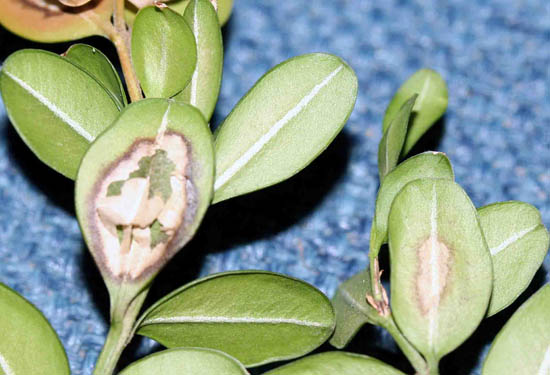Issue 7, June 5, 2009
Boxwood Leafminer
We have had several cases of boxwood leafminer, Monarthropalpus buxi, sent in to the plant clinic this spring. Boxwood leafminer causes off-green pouches on leaves that turn brownish as the larvae mature. Because partially-grown larvae overwinter, heavily affected leaves develop light brown mottling in the spring when other foliage is green. This mottling occurs on both the under- and uppersides of the leaves.

Adult flies emerge from pupae when weigela begins to bloom. In central Illinois, weigela just finished blooming, thus adult fly emergence would have occurred in mid-May. The adult flies are tiny yellowish-orange flies about pinhead-sized. Female flies land on the leaf upperside and insert eggs into the leaf tissue. These eggs hatch into yellowish-white larvae (maggots) that feed on the mesophyll tissue in the interior of the boxwood leaf. About twenty larvae are commonly present per leaf. They develop slowly through the summer, initially causing raised, green blisters on the leaf upperside and small, tan blisters on the underside. After overwintering, the mature larvae cause the lower epidermis of the leaf to separate and appear whitish. If many larvae are present, this will happen to the entire leaf underside.
Many insecticides are effective to control the flies during egg-laying, and may still be effective in northern Illinois. These include carbaryl (Sevin) and labeled pyrethroids. Abamectin (Avid), acephate (Orthene), and imidacloprid (Merit and others) can be applied throughout the state in June as these systemic insecticides will penetrate the leaf tissue and control the larvae.--Phil Nixon
Author:
Phil Nixon